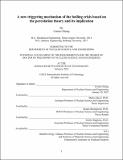A new triggering mechanism of the boiling crisis based on the percolation theory and its implication
Author(s)
Zhang, Limiao
DownloadThesis PDF (19.03Mb)
Advisor
Bucci, Matteo
Terms of use
Metadata
Show full item recordAbstract
Boiling is a very effective heat transfer process, used in nuclear reactors and other applications such as high-performance computing cooling, sterilization, water desalination. However, this process is limited by the boiling crisis. The boiling crisis is an instability that causes a sudden transition from a nucleate boiling regime to a film boiling regime. The value of the heat flux at which this boiling crisis occurs is known as critical heat flux (CHF). The boiling crisis is likely to make overheated heaters to burn out and fail. Thus, systems are typically operated with an adequate margin to the CHF limit.
Researchers have spent decades exploring the triggering mechanism of the boiling crisis. Historically, most models assumed that boiling crisis is triggered by a macroscale hydrodynamics instability in the far-field liquid-vapor flows. However, there is a growing consensus that the boiling crisis is a near-wall phenomenon. In summary, while the boiling crisis has been studied for almost a century, there is still no consensus on the triggering mechanism of the boiling crisis.
Recent observations from our group and other groups suggest that the boiling crisis is a scale-free phenomenon and belongs to the universal class of critical phenomena including earthquakes, traffic jams, and the outbreak of COVID-19. Inspired by the new observations, we propose a new way to view boiling heat transfer and the boiling crisis by modeling boiling as a bubble percolation process. By combining high-resolution experimental data and a stochastic model, we posit that the boiling crisis is triggered by an instability in the near-wall stochastic bubble interaction process. We formulate a Monte Carlo (MC) simulation model based on the continuum percolation theory that elucidates how the scale-free distribution emerges from the bubble percolation process. This model allows formulating a unifying nondimensional law of the boiling crisis, which we verify using data from eleven different surface and operating conditions.
Inspired by the concurrence of scale-free criticality and complexity in many of the aforementioned physical systems, we analyze the fractal behavior of the bubble interaction process and show that the critical phase transition in this phenomenon (i.e., the boiling crisis), coincides with a maximum in the fractal dimension (i.e., the maximum complexity in the system). We also reveal that nucleate boiling (not the boiling crisis) is a self-organized process that belongs to the universal class of phenomena with a self-organized criticality.
Date issued
2022-02Department
Massachusetts Institute of Technology. Department of Nuclear Science and EngineeringPublisher
Massachusetts Institute of Technology